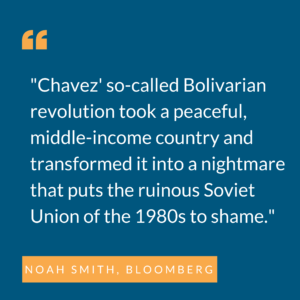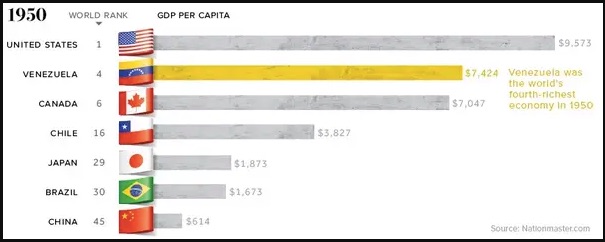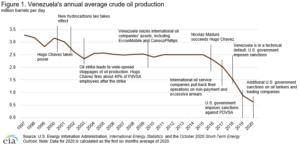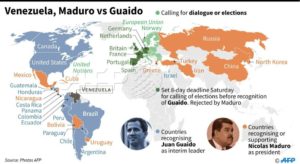In the 1950s, Venezuela was the fourth wealthiest country in the world. Today, Venezuela is poorer than it was prior to the 1920s, its infrastructure is deteriorating, and its economy has been shrinking since the turn of the century. Hyperinflation (out of control price increases) has left the currency worthless and made it almost impossible for Venezuelans to afford basic necessities. Millions have fled the country’s inhospitable conditions. How did the country go from having a GDP on par with that of the United States, New Zealand, and Switzerland to having almost 90% of the population living in poverty?
Podcasts
View the Executive Summary for this brief.
Listen to The Civic Leader Podcast for an audio version of this brief.
To begin, listen to our podcast of Co-founder, Sylvie Légère, hosting a Conversation Call with special guests to discuss this newsworthy topic.
In addition, listen to Angela Braly, Co-founder of The Policy Circle, interviewing Emilio Pacheco, who was born and raised in Venezuela where he lived until 1987, about his experiences.
Introduction
This brief takes a closer look at Venezuela’s past and present social, political, and economic circumstances, the role socialist policies played, and how this relates to conversations within our own government. Understanding the history of such an evolution is an important way to keep similar tendencies from reaching other shores, including our own.
Case Studies: On the Ground in Venezuela
In what was once Latin America’s richest nation, over 75% of Venezuelans are living in extreme poverty. According to a September 2021 report from the National Survey of Living Conditions, created in 2014 to make up for the absence of official data, the percentage of Venezuelans living in extreme poverty rose from 67.7% to 76.6%. This is a reversal of the improvement in previous years after the government started cash transfers and relaxed price controls. The COVID-19 pandemic has exacerbated the crisis in Venezuela that had already been ongoing for years; before the pandemic, the UN World Food Programme estimated one-third of Venezuelans struggled to get enough food to meet the minimum nutritional requirements.
The U.S. State Department announced in September 2021 that it was sending $247 million in humanitarian assistance and $89 million in economic and development assistance to aid “Venezuelans in their home country and Venezuelan refugees, migrants, and their host communities in the region.” This includes $120 million from the State Department’s Bureau of Population, Refugees and Migration; and $216 million through the U.S. Agency for International Development (USAID), bringing total U.S. humanitarian, economic, development, and health assistance for the Venezuela crisis to more than $1.9 billion since 2017. This includes:
- Food assistance;
- Emergency shelter;
- Access to health care, water, sanitation, and hygiene supplies;
- COVID-19 support;
- Protection for vulnerable groups including women, children, and indigenous people;
- Assistance to democratic actors within Venezuela;
- Integration support for communities that host Venezuelan refugees and migrants, “including development programs to expand access to education, vocational opportunities, and public services.”
As of early 2022, more than 7 million Venezuelans in Venezuela are in critical need, and almost 6 million have fled to 17 countries across the region.
Why it Matters
What separates Venezuela from similar nations is its history of centralizing power, its government overreach, and its inability to “stabilise external and fiscal accounts.” By imposing price controls, expropriating private property, and conducting large-scale industry nationalization, the Venezuelan government wrecked the economy and eliminated the economic freedom of its citizens. The “dismantling of democratic checks and balances, and sheer incompetence” led to Venezuela’s collapse.
The media have assigned blame for Venezuela’s humanitarian crisis on causes such as falling oil prices. However, Saudi Arabia, Nigeria, and Kuwait are also petrostates that saw their incomes fall when oil prices dropped, but emerged from recession with their economies intact. Additionally, although President Maduro has blamed the U.S. and its imposed sanctions, none of these sanctions were broad enough to inflict the type of damage Venezuela is currently suffering.
The regimes of Presidents Hugo Chavez and Nicolás Maduro decimated the country through “relentless class warfare and government intervention in the economy.” Maintaining basic freedoms and remaining committed “to the rule of law, limited government, and checks and balances” is what separates true democratic nations from Venezuela, and what the rest of the world must remember to adhere to.
Putting it in Context
Oil Boom (1940s-1970s)
Geologists from Royal Dutch Shell struck oil in the northeast region of Venezuela in 1922. Annual production during the 1920s increased from about 1 million barrels to 137 million, putting Venezuela second only to the U.S. in total oil output. By the mid-1930s, oil totaled 90% of exports and was pushing out all other economic sectors. However, foreign companies, including Royal Dutch Shell, controlled 98% of Venezuelan oil. In response, the Venezuelan government enacted a law in 1943 that required “foreign companies to give half of their oil profits to the state. Within five years, the government’s income had increased sixfold.”
Venezuela’s prominence in the oil market and government oversight of the industry was a constant throughout the 1940s and 1950s. In 1960, Venezuela became a founding member of the Organization of the Petroleum Exporting Countries (OPEC), through which the world’s largest oil producers coordinate prices to give states more control. Joining OPEC substantially benefited Venezuela during the 1970s, when an OPEC embargo during the Yom Kippur War caused oil prices to soar. Venezuela’s per capita income quickly became the highest of any country in Latin America as oil revenues quadrupled. In 1976, President Perez created the state-run oil company Petroleos de Venezuela, S.A (PDVSA) to supervise the oil industry.
Oil Bust (1980s-2000s)
In the 1980s, global oil prices plummeted due to crude oil surpluses after the 1970s energy crisis. As Venezuela was almost entirely reliant on oil, the price crash brought Venezuela’s economy down with it. In 1989, President Perez implemented an austerity package as part of an International Monetary Fund bailout. Riots and strikes ensued, followed by an attempted coup by Hugo Chavez in the early 1990s. Although unsuccessful in his initial overthrow attempt, Chavez rose to fame and was elected president in 1998.
Once in power, Chavez raised oil income taxes on foreign companies in Venezuela. He promised to use the revenues to expand government-run welfare programs, hire more government workers, raise the minimum wage, and redistribute land. Meanwhile, the state-run oil industry faltered due to the control structure of the government. After a strike in 2002-2003, Chavez fired thousands of PDVSA workers and replaced them with loyal supporters with little technical and managerial expertise. Foreign investors and oil firms disliked the government interference, lost faith in PDVSA, and stopped operations.
Collapse (2000s-Present)
In an attempt to gain more control over the economy, President Chavez went on a nationalization spree in the 2000s that pushed out all private enterprise, starved industries of technical expertise and investment, and sent government-controlled institutions into a downward spiral. Exchange rate controls and price controls “broke the basic link between supply and demand, creating surreal economic distortions.” For more on supply and demand, markets, and price controls, see The Policy Circle’s Free Enterprise & Economic Freedom brief.
This suffocated private enterprise. Price controls prevented private businesses from setting their own prices, making it nearly impossible to make a profit. Both foreign- and domestically-owned companies stopped investing in Venezuela, and new businesses did not replace them due to red tape, corruption, and fear their private property was not secure. In 2011, Latin America received over $150 billion in foreign investment; Venezuela only accounted for $5 billion of this amount, while neighboring Brazil received $67 billion. Investment has only declined further since then; in 2019, Brazil received $72 billion, Colombia $14 billion, and Chile $11 billion, while Venezuela received less than $1 billion.
Chavez garnered strong relationships with countries such as China, Russia, and Cuba to endure the inevitable disasters of his policies. He frequently announced new government programs to deliver free or heavily discounted goods that resulted from these relationships, such as refrigerators and cars, to the poorest in the nation. These efforts kept the worst case scenario of Venezuela’s impending crisis at bay, and also continuously won Chavez popular sentiment around election times. This stopped when Chavez died, reportedly of cancer, in 2013.
Chavez’s vice president, Nicolas Maduro, assumed the presidency in 2014, but this did not change the economy’s trajectory. Oil prices tumbled, inflation reached over 50 percent, prompting Maduro to cut public spending. By mid-2016, hundreds of thousands of Venezuelans were protesting. Maduro’s response was to crack down on dissent.
For more on Venezuela’s history, Hugo Chavez, and Nicolás Maduro, watch The Collapse of Venezuela, Explained:
The Role of Government
Venezuela’s situation was the product of years of government policies and economic mismanagement. The clear signs of trouble came from a charismatic leader who promised the nation that government was a solution to their woes, and made the country dependent on one resource while shutting down competition, diversity of opinion, and debate. It might seem strange that such a chain of events could happen without notice, but the slow dissolution of democracy often happens while many blindly laud the intermediary steps.
Bolivarian Revolution
Chavez identified with the Venezuelans who suffered under the IMF-backed austerity measures during the late 1980s and mid 1990s, and his campaign promise was to use his power to distribute public and private oil revenues to the poor. Chavez spent these funds on social services and welfare programs. The social programs, called “misiones,” delivered basic services for education, health, employment, and food. There was practically no limit to these welfare programs; one year, the government handouts included approximately 200,000 homes.
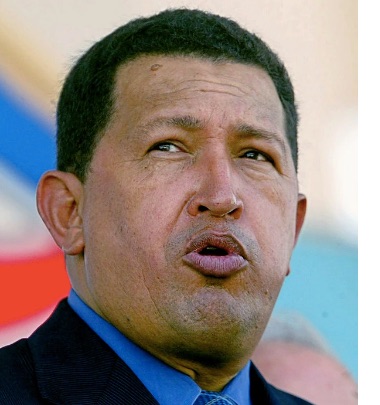 This “Bolivarian Revolution” initially improved a number of social indicators such as literacy, income per capita, unemployment rates, and infant mortality. Between 1999 and 2011, Venezuela’s Gini coefficient (a measure of income inequality) fell from almost .5 to .39, meaning Venezuela at the time had the “fairest income distribution” in all of Latin America and ranked just ahead of the U.S. and only behind Canada in the Western Hemisphere. Between 2003 and 2013, poverty levels fell from 61% of the population to 34%.
This “Bolivarian Revolution” initially improved a number of social indicators such as literacy, income per capita, unemployment rates, and infant mortality. Between 1999 and 2011, Venezuela’s Gini coefficient (a measure of income inequality) fell from almost .5 to .39, meaning Venezuela at the time had the “fairest income distribution” in all of Latin America and ranked just ahead of the U.S. and only behind Canada in the Western Hemisphere. Between 2003 and 2013, poverty levels fell from 61% of the population to 34%.
Nationalization
Chavez’s economic model intended to have community enterprises working alongside the private sector, but government overreach meant national agencies, co-ops, and state industries comprised the bulk of the economy. Starting in 2007, the government used oil revenue to buy the largest electricity and telecommunications companies. It also seized the largest agricultural supplies company, the largest steel producer, glass producer, and the three largest cement industries.
These produced little return, and co-ops in particular often “wound up in the hands of incompetent and corrupt political cronies.” Additionally, private enterprises suffered a number of state-imposed regulations and high taxes. International airlines stopped servicing flights to Venezuela, and businesses including General Motors, Clorox, and Kellogg’s, at risk of having their assets taken by the state, fled the inhospitable economic conditions. The World Bank’s Doing Business 2020 report listed Venezuela as one of the worst countries in which to do business, ranking it 188th out of 190 countries.
Freedom of Speech
Government oversight of the media and efforts to stop coverage of the opposition have escalated in recent years. The government has threatened news outlets that cover the opposition, shut down radio stations, raided television channel offices, and blocked websites. A number of international journalists have been arrested and deported; even veteran Univision News anchor Jorge Ramos was detained during any interview with President Maduro. In May 2021, government forces seized the headquarters of the newspaper El Nacional after the Supreme Court ordered it to pay defamation damages (the Supreme Court has been accused of lacking judicial independence). Additionally, since the COVID-19 state of emergency was enacted, many people sharing or publishing information on social media that questions officials or policies are charged.
Freedom House, an international organization that analyzes challenges to freedom, ranks Venezuela as “not free” in terms of political rights and civil liberties. Article 57 of Venezuela’s 1999 constitution guarantees freedom of expression and article 51 guarantees the right to access public information. However, the 2004 Law on Social Responsibility in Radio, Television, and Electronic Media bans any content that could “’incite or promote hatred,’” or “’disrespect authorities.’” As in other authoritarian countries, in Venezuela there is no protection for either citizens or the media to speak out against the government.
Suppression of Opposition
Venezuelan security forces routinely use tear gas and rubber bullets to suppress protesters. In 2016, Maduro responded to massive demonstrations involving over 6 million Venezuelans by banning street protests, which led to over 130 deaths and almost 5,000 arrests. In 2017, United Nations Human Rights officials were not allowed into the country during an investigation of over 120 deaths that could have been related to government forces.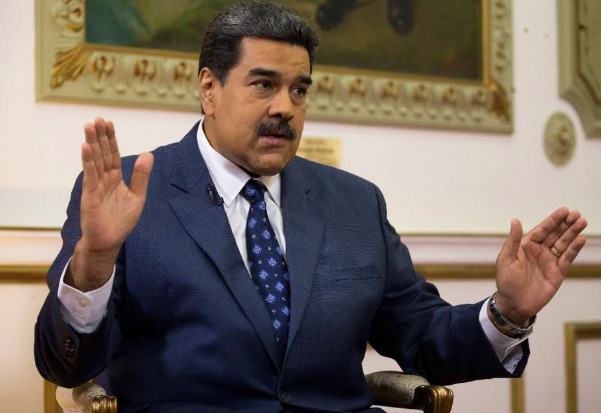
Many protests have been in response to government attempts to consolidate power. In 2015, the opposition party gained a two-thirds majority in Venezuela’s congress, the National Assembly. President Maduro then stripped the congress of its constitutional powers and replaced it with a Constituent Assembly packed with legislators loyal to Maduro’s regime. Maduro also declared the assembly’s Supreme Court appointments illegal, and replaced the Supreme Court with a parallel Supreme Tribunal of Justice, also packed with new magistrates that Maduro trusted.
“Free and Fair Elections”
Suspicious activity surrounded the 2018 Venezuelan presidential election. In the months leading up to the election, Maduro blocked opposition parties from participating or campaigning and arrested opposition candidates.
After voting, many people visited “Red Spots,” pro-government booths where they could receive government subsidized food boxes, and give “their names to workers who were keeping lists of those who had voted.” Although workers claimed there was no effort to “link a pro-Maduro vote to future food deliveries,” one woman said she felt “compelled to vote for Mr. Maduro” and feared she would lose her government job if she did not give her name at the Red Spot.
The results revealed Maduro had received 5.8 million votes (for comparison, he received 7.5 million votes in the 2013 election after Chavez’s death). His main rival Henri Falcón, who ran even though fellow opposition members called for an election boycott, received 1.8 million votes. Maduro claimed victory, but the organization Observación Ciudadana (Citizen Observation) and several international organizations denounced the results, listing cases of coercion, intimidation, and the fact that only 46% of Venezuelans voted on election day. For the 3 previous presidential elections in 2006, 2012, and 2013, between 70 and 80 percent of the population voted.
To understand more about how Venezuela’s 2018 elections violated Venezuelan Law and internationally recognized standards, take a look at this infographic.
Current Challenges
The Oil Curse
How did the nation that is home to the world’s largest oil reserves find itself in its current situation, so different from that of Saudi Arabia with the second largest oil reserves? According to political scientist Michael Ross, part of Venezuela’s crisis stems from becoming dependent on its most abundant resource: oil.
Using oil revenues for social change continuously deepened the dependence on the resource. There was little concern when oil prices were high in the mid-2000s, but prices fell in 2014 and Venezuela no longer has the funds to import what it does not produce at home. For this reason, welfare programs have been cut back, including government food handouts called CLAP boxes. In 2018, one researcher at the University of Venezuela claimed the boxes supplied about half of Venezuelans’ food requirements, and noted that the boxes dropped from 16 kilograms in January to 11 kilograms in May.
Chavez “did little to improve how Venezuela actually makes money. He paid no attention to diversifying the economy in domestic production outside of the oil sector.” Instead of relying on an entrepreneurial economy to produce a variety of goods and services to generate wealth, Chavez’s policies made citizens dependent on one commodity.
Production
Many Venezuelans were initially excited when Chavez rose to power. But not all has gone according to plan; the country’s GDP (Gross Domestic Product) has plummeted since 2012, and the International Monetary Fund estimates Venezuela’s GDP is around $50 billion (neighboring Colombia’s GDP is over $350 billion, and the U.S.’s is over $24 trillion). Domestic production plunged and food imports soared; according to the director of Venezuela’s Confederation of Associations of Agricultural Producers, Venezuela went from producing 70% of its food to importing 70% of food. All materials from seeds to fertilizer are provided by the government, but farmers report they often do not receive supplies. Additionally, the government-controlled steel industry does not produce enough machinery and inflation has made it almost impossible to afford importing new equipment.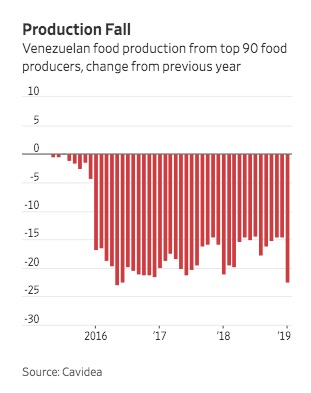
Inflation
Oil revenues allowed Venezuela to import goods from abroad, but when oil revenues declined, Venezuela could no longer import the goods it did not produce itself. The scarcity of goods drove prices up, resulting in massive inflation. The price controls under President Chavez made necessities more affordable, but it was no longer profitable for businesses to make them. As a result, people were forced to turn to the government for handouts or to the black market.
President Maduro repeatedly increased the minimum wage in an attempt to combat inflation. In August of 2018, a 3000% increase equated to about $20 a month. This had almost no effect; almost 90% of Venezuela’s population lived in poverty and prices were doubling on average every 19 days by the end of 2018.
Over the summer of 2019, the Maduro regime scaled back on price controls, printing money, minimum wage increases, and regulating importers and businesses. Inflation has fallen from over 1 million percent in mid-2018 to 2,500% in late 2021, to about 500% in mid-2022. The massive emigration of Venezuelans has also boosted the economy, since those who fled send remittances back home in the form of dollars, which retailers in large cities like Caracas are now accepting. By one estimate, two-thirds of all transactions in Venezuela take place in foreign currencies, mainly the U.S. dollar. Despite the drop, inflation is still sky-high (see the $15 cereals), most Venezuelans still depend on nearly worthless bolivars, and the national minimum wage still equates to less than $2 per month. The COVID-19 pandemic has only exacerbated the situation, as the number of Venezuelans living in extreme poverty spiked by 10%.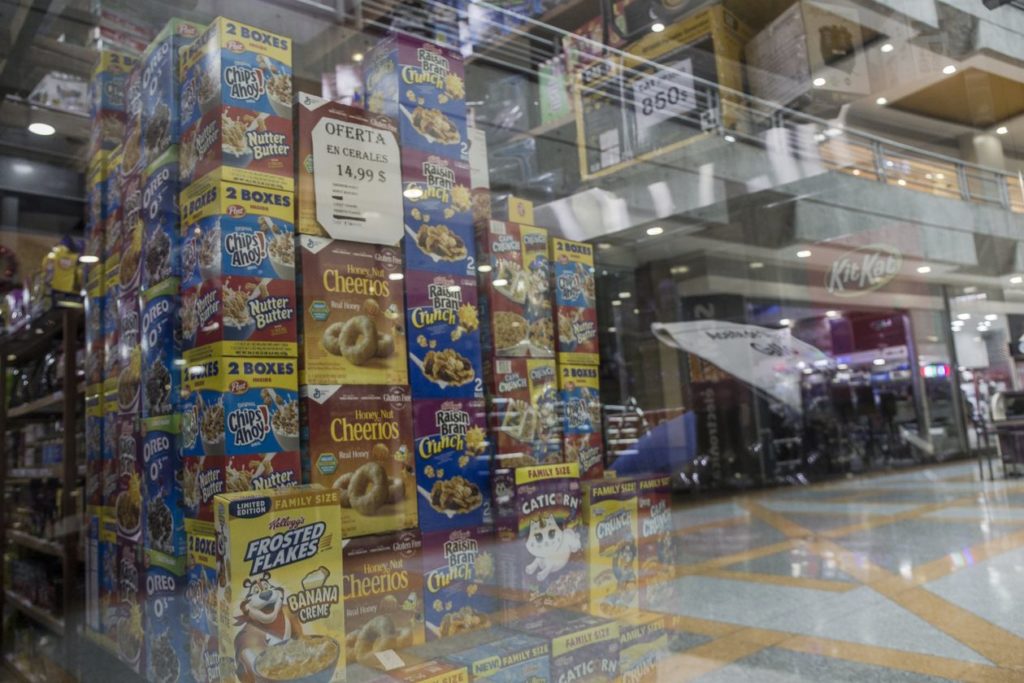
Education
As the economy crumbled, education became a luxury. Students went to school primarily to receive the state-sponsored meals, but the buildings lack water and electricity. Each start of the school year, thousands of teachers do not show up to classes, having opted for different jobs that earn slightly more money or trying their luck abroad. This video from the Washington Post illustrates the enrollment and staffing troubles in the country that were prevalent before COVID-19. UNICEF reported 6.9 million students in Venezuela missed almost all classroom instruction between March 2020 and February 2021.
Post-secondary education is also suffering. Simon Bolivar University, dubbed Venezuela’s “University of the Future,” was government-funded since it opened in 1970, but alumni living abroad have been financing the university with private donations and teaching classes via Skype. Professors can only expect to earn the equivalent of $25 per month, prompting many to flee the country. Over 430 faculty and staff members left the university between 2015 and 2017.
Healthcare
Education is not the only sector experiencing brain drain; over 20,000 doctors have fled Venezuela’s inhospitable conditions since 2014. Medical professionals have been attacked by patients’ relatives, frustrated by the supply shortage and machine and infrastructure failures ranging from power outages to water shortages. Across the country, hospitals face shortages of basic medicines such as those to control hypertension or diabetes, and high-cost medicines for cancer, Parkinson’s and multiple sclerosis are no longer imported. Treatments such as organ donations and transplants stopped in 2017.
The 1996 Constitution guaranteed the right to health as “an obligation of the State,” but the State has instead reduced funding, silenced practitioners, and censored health system publications. The government spends about 1.5% of GDP on healthcare, which is 75% lower than the world standard.
In 2015, Venezuela’s Health Ministry “stopped publishing weekly updates on relevant health indicators.” When health minister Antonieta Caporale briefly resumed updates in 2017, she was immediately fired. The statistics revealed that between 2016 and 2017, maternal mortality rose 65% and infant mortality rose 30%. Tuberculosis, diphtheria, measles, and malaria are also creating emergency situations, and disease is accompanied by widespread malnutrition. According to WHO standards, malnutrition among children under the age of 5 in Venezuela has reached “crisis level.” A university study found that, on average, almost two-thirds of Venezuelans surveyed lost about 25 pounds in 2017. (Human Rights Watch, CEPAZ). Venezuelans called this the “Maduro Diet,” as noted in this poignant letter.
The situation has not improved through the COVID-19 pandemic; Monitor Salud, an NGO, reported 83% of hospitals have insufficient or no access to personal protective equipment, and 95% lack sufficient cleaning supplies. Estimates indicate only about a quarter of the population is fully vaccinated.
Refugee Crisis
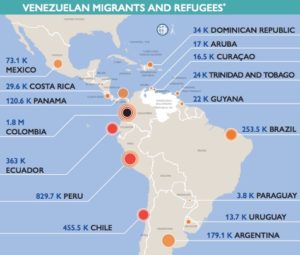 Venezuela is now the origin of one of the largest mass migrations ever on the Latin American continent. As of early 2022, almost 6 million people have fled the shortages of food, water, and medicine. Former doctors and engineers work as waiters or store clerks in Colombia and Peru to send remittances back to family members who remain in Venezuela, but they frequently face hostility from citizens of other nations who accuse Venezuelans of stealing their jobs.
Venezuela is now the origin of one of the largest mass migrations ever on the Latin American continent. As of early 2022, almost 6 million people have fled the shortages of food, water, and medicine. Former doctors and engineers work as waiters or store clerks in Colombia and Peru to send remittances back to family members who remain in Venezuela, but they frequently face hostility from citizens of other nations who accuse Venezuelans of stealing their jobs.
Colombia, Venezuela’s neighbor to the west, is absorbing most of those fleeing; although Colombia closed the border with Venezuela to try to stem the spread of the coronavirus, in February 2021, Colombia’s President Iván Duque announced the government would “provide temporary legal status to the more than 1.7 million Venezuelan migrants who have fled to Colombia in recent years.” Hundreds of thousands more pass through Colombia on their way to other countries including Peru, Chile, and Ecuador. Venezuelans now need a passport or visa to travel to other Latin American countries, when they previously only needed national identity cards. This adds insult to injury as passports are difficult to obtain given “paper shortages and a dysfunctional bureaucracy.”
See more about how Colombia is handling this refugee crisis here:
Infrastructure
Intermittent power outages are a regular occurrence, but a massive outage that affected 22 of Venezuela’s 23 states in early March 2019 revealed the severity of the state of Venezuela’s energy infrastructure. Pro-government officials blamed Venezuela’s opposition party, claiming they had sabotaged Venezuela’s hydroelectric Guri Dam as part of an “electricity war” directed by the U.S. Energy experts, power sector contractors, and employees from the government energy company attributed the problems to “years of underinvestment, corruption and brain drain.” Skilled operators “had long left the company because of meager wages and an atmosphere of paranoia.”
The fallout has only exacerbated the suffering of the Venezuelan people. Looters started ransacking businesses for food and supplies. Gas stations could not pump fuel, causing many to turn to the black market for gasoline in “a country that subsidizes fuel to the point that it is nearly free.” According to Julio Castro of the organization Doctors for Health, at least 20 people died in public hospitals due to the outages; damaged or drained back-up generators could not keep machines required for dialysis, incubators, and artificial ventilation running.
These photos from The Guardian illustrate the effect of the blackout in Caracas.
Aid
During the first week of February 2019, international aid reached the Colombian and Brazilian borders. President Maduro ordered troops to barricade bridges at the borders to prevent aid from entering. Over 300 low-ranking soldiers fled their posts that weekend, but they are a small fraction of the 200,000 troops that remained loyal to Maduro and refused to let the trucks filled with food and medicine cross the border. Listen to this NY Times podcast on the humanitarian aid debacle in February 2019.
Maduro repeatedly denied the extent of the crisis in Venezuela, and said any aid efforts from the U.S. or other countries were “part of a hostile foreign military intervention.” At the end of March 2019, however, Maduro reached an agreement with the international Red Cross to deliver aid. The first shipment reached Venezuela in mid-April. By September 2019, the aid was only making small improvements and shortages in medicines still persist. Over the summer of 2020, Venezuela’s opposition party reached an aid agreement with the Pan American Health Organization, specifically to help Venezuela respond to the pandemic, but Human Rights Watch reported in December 2020 that Venezuelan authorities were “freezing bank accounts, issuing arrest warrants, and raiding offices” or humanitarian groups operating in the country.
International Entanglement
Despite the controversy surrounding the 2018 election controversy, but Mexico, Turkey, Iran, Bolivia, Nicaragua, China, and Russia continue to recognize the Maduro regime. China in particular has offered technical assistance to help restore the country’s electrical grid. Additionally, China and Russia vetoed a United Nations Security Council vote in February to condemn the May 2018 elections and call for international humanitarian aid for Venezuela.
Russia and Venezuela have a long history in the oil industry. Since 2015, Rosneft, the Russian state-controlled oil firm, has increased its loans to Venezuela and its shareholder stakes in a joint venture with PDVSA. A Reuters investigation uncovered documents revealing that equipment is scarce, oil output is far lower than projected, and there is a “$700 million hole in the balance sheet of the joint venture.” Still, Venezuela buys Russian weapons, which gives Russia an incentive to stand by its ally and even provide military support. However, “Russian banks, grain exporters, and even weapons manufacturers have all curtailed business with Venezuela.”
Cuba is also heavily involved with Venezuela’s oil industry. In the early 2000s, Cuban leader Fidel Castro signed a deal with Hugo Chavez to provide Cuba with crude oil in exchange for Cuban professional staff and intelligence and security agents to go to Venezuela. Venezuela’s oil production has collapsed and Cuba gets far less oil than the agreement states, but Cuba’s reliance on Venezuelan oil and the countries’ long-standing allegiances to one another are incentives to support the Maduro regime. The opposition has criticized this longstanding agreement.
Citgo
Tension has surrounded Citgo, a wholly-owned subsidiary of Venezuela’s PDVSA operating in the U.S. Citgo manages three refineries in the U.S. and amounts to about 4 percent of U.S. fuel. The Citgo business relationship has been strained, especially after Treasury Secretary Steven Mnuchin imposed sanctions on Venezuela’s PDVSA “so that any new profits would be deposited in an account under Guaidó’s authority,” although the administration has yet to figure out how to disburse these funds to Guaidó. In recent months, this has become a serious problem for Guaidó, whose National Assembly would need to make a $913 million payment to PDVSA bondholders to maintain control of Citgo.
The Future for Venezuela
Opposition Uprising
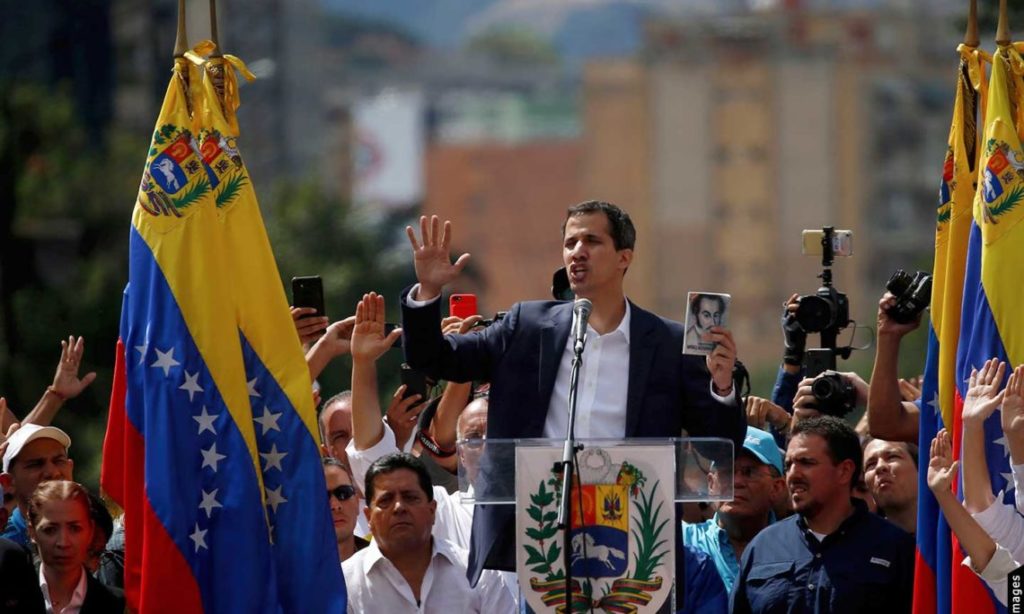 Despite the international community’s condemnation of the elections, Maduro began his next six-year term with an inauguration ceremony on January 10, 2019. Barely two weeks later, mass demonstrations broke out in Caracas in support of Juan Guaidó, head of the National Assembly. Given the contested election results, Guaidó claimed Maduro was usurping the presidency by staying in office and that Guaidó could assume power based on Article 233 of the Venezuelan Constitution, which states: “If at the outset of a new term there is no elected head of state, power is vested in the president of the National Assembly until free and transparent elections take place.” He swore himself in as interim president on January 23, 2019.
Despite the international community’s condemnation of the elections, Maduro began his next six-year term with an inauguration ceremony on January 10, 2019. Barely two weeks later, mass demonstrations broke out in Caracas in support of Juan Guaidó, head of the National Assembly. Given the contested election results, Guaidó claimed Maduro was usurping the presidency by staying in office and that Guaidó could assume power based on Article 233 of the Venezuelan Constitution, which states: “If at the outset of a new term there is no elected head of state, power is vested in the president of the National Assembly until free and transparent elections take place.” He swore himself in as interim president on January 23, 2019.
Pressure from Abroad
On January 23, 2019, the U.S. recognized Guaidó as the leader of Venezuela, which prompted a series of U.S. sanctions against the Maduro regime. In August 2019, these sanctions turned into a total economic embargo. Most of Europe called for re-elections by the end of January, and Spain, Britain, France, and Germany endorsed Guaidó after Maduro refused to hold elections again. At the end of January 2019, European Union lawmakers voted 439 in favor to 104 against (with 88 abstentions) to recognize Guaidó until “new free, transparent and credible presidential elections” take place. The EU parliament has no foreign policy powers, but does have symbolic importance, especially in the realm of human rights. Also in the realm of human rights, the International Criminal Court prosecutor announced in November 2021 the decision to open an investigation into possible crimes against humanity committed in Venezuela.
Maduro severed diplomatic relations with the U.S. For more on the tense relationship between the U.S. and Venezuela and how it’s affecting conditions right now, check out this BBC video.
Violence and political stalemate continue. Peace talks over the summer of 2019 between the two sides did little in the way of reaching a compromise. In January 2021, the opposition party boycotted national elections, which means technically Gauidó’s term as congressional speaker expired. Many Latin American and European nations have “distanced themselves” from the opposition as they cannot justify “recognizing a leader who has no control over the country,” although the U.S. still offers its support. The Maduro government and the opposition held meetings in Mexico in August 2021 to negotiate, but the government withdrew in October 2021 and negotiations have not restarted.
Meanwhile, Venezuela’s crisis situation shows no signs of improving. As governments and factions compete for power, the people of Venezuela continue to suffer.
Ways to Get Involved/What You Can Do
- Be in the know on Venezuela issues and share with your friends, colleagues and family:
- Check out this Policy Circle Brief on Free Enterprise & Economic Freedom or It’s a Wonderful Loaf from Russ Roberts at Stanford University’s Hoover Institution for more on markets and how they are affected by government interference
- Listen to The Policy Circle’s Conversation Call about Venezuela
- Keep track of bills in Congress related to Venezuela.
- Engage
- Know who decides policy in Venezuela: Stay up to date with information from the House Foreign Affairs Committee and the Senate Committee on Foreign Relations
- Organize a community gathering about aid, policy, and what your tax dollars are going to support in foreign countries.
- Pose any questions in a written piece for your local publication to make others in your community aware and seek answers. Check out the Policy Circle’s guide to writing an Op-Ed.
